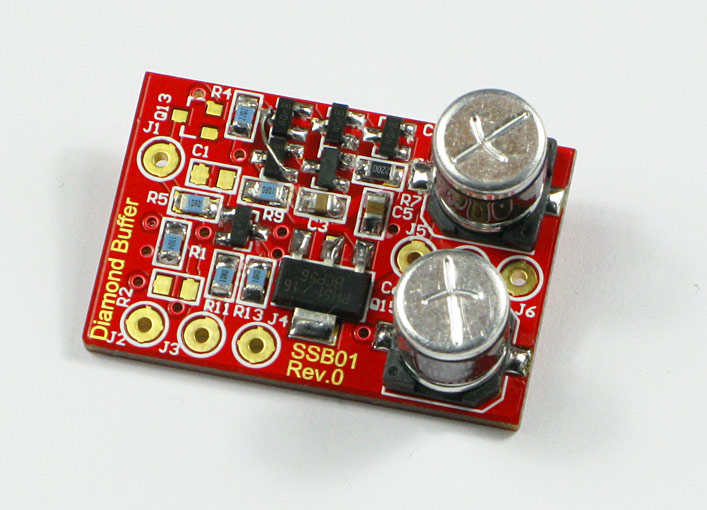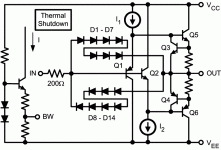Is the LME49720 the optimum choice for the servo? I would have thought that a FET op-amp with a low offset would be better here. And then perhaps increase the value of R14 and R17 to attenuate noise from the op-amp?
With the LME49720 there could be 11mV offset from the offset current + the 1M resistors. With e.g. LF411 this could be reduced to 0.5mV from the offset voltage. The error from the offset current would be only 25uV (typical at 25 deg C) and 100uV max.
Of Course National would like to sell a lot of LME49720's, but it may not be the best choice for the servo.
With the LME49720 there could be 11mV offset from the offset current + the 1M resistors. With e.g. LF411 this could be reduced to 0.5mV from the offset voltage. The error from the offset current would be only 25uV (typical at 25 deg C) and 100uV max.
Of Course National would like to sell a lot of LME49720's, but it may not be the best choice for the servo.
Nice layout, Neb! Do wonder about that transformer, it seems a bit small. Judging from va rating it should be ok but at max current it is perhaps a bit skimpy (not that you'll still have eardrums at max current 🙂 ).
might I suggest you add an soic8 pattern inside and connected to the dip8 so people can choose to use soic8 directly instead of having to use an adapter? just about all modern high performance opamps are nolonger made in dip8, only SMD and high bandwidth/speed chips and their decoupling will perform better if connected to the PCB and opamp pins directly
http://www.national.com/pf/LM/LME49600.html#Overview
Just an engineering question, what are the advantages of placing a buffer in the feedback of the non-inverting configuration as shown in the schematic? I'm sure the answer lays in a lump of nodal calculations but asking an engineer saves me a little work 😛
You add a buffer if the load is too heavy. A buffer will increase distortion performance and the possibility to have a heavier load.
I am still learning about electronics, so please pardon any stupid questions i ask.
Is is possible to use the LME49600 in a headphone amp by itself?
My source has no problem driving my headphones to high volume, and it should be ok to have no gain.
Yes, I believe so. Most sources have plenty of voltage to drive the headphones to maximum, but not enough current. The LME49600 can provide the current.
Did anyone try to build this eBay - New & used electronics, cars, apparel, collectibles, sporting goods & more at low prices ? their design used lme49710 + lme49600, or any comment?
Yes, I built that amp and wrote about it here:
http://www.diyaudio.com/forums/headphone-systems/206431-my-head-phone-amp-project.html
Jim's Audio boards are good quality in my opinion, with complete gold plating and plated through holes. The schematic as provided has way too much gain, but that's an easy fix.
A servo is not required.
I have made a version called SSB01
Parts on both sides and it's a 4-layer board.
http://www.diyaudio.com/forums/blogs/peranders/197-free-pcbs-me.html

Parts on both sides and it's a 4-layer board.
http://www.diyaudio.com/forums/blogs/peranders/197-free-pcbs-me.html

Last edited:
My DIY AMP - National Amplifier Schematic (LME49720+LME49600)
photo:
Distorsion test on my EMU1212 gives very low THD & IMD.
AMP used as portable.
With my Beyerdynamic DT990 PRO's sounds very cool!
Sorry for bad English...
photo:
An externally hosted image should be here but it was not working when we last tested it.
Distorsion test on my EMU1212 gives very low THD & IMD.
AMP used as portable.
With my Beyerdynamic DT990 PRO's sounds very cool!
Sorry for bad English...
Last edited:
So, why were the files removed?
If you're referring to the National website files, it's because TI has bought them and has recently moved the documents over to their website.
If you're referring to other files, then I have no idea.
So, do you find that 6dB is too much gain? Given that most headphones are plenty loud @ 1Vrms input, and that a typical CD play puts out up to 2V, then I would think that a buffer is all that is needed for a decent headphone amp.
Also, the LME49600 is just a diamond buffer with a couple of bells and whistles. It would be more fun to me to try to outperform their chip by designing our own discrete version.
- Status
- Not open for further replies.
- Home
- Amplifiers
- Headphone Systems
- National LME49600 Reference Design Project


